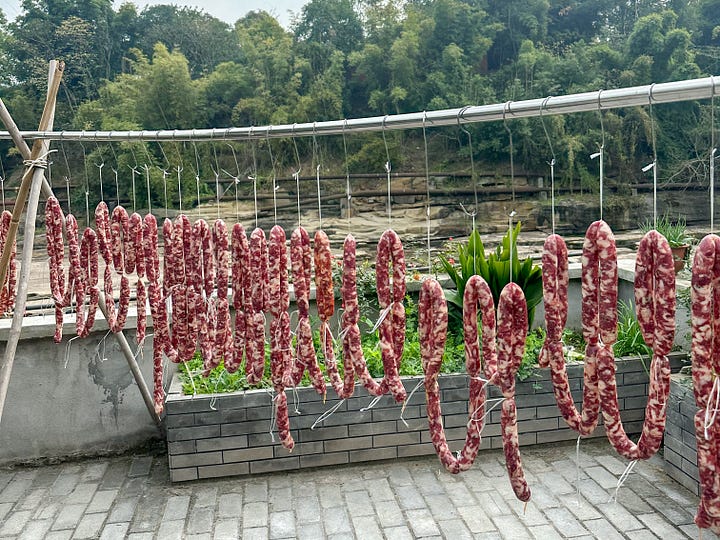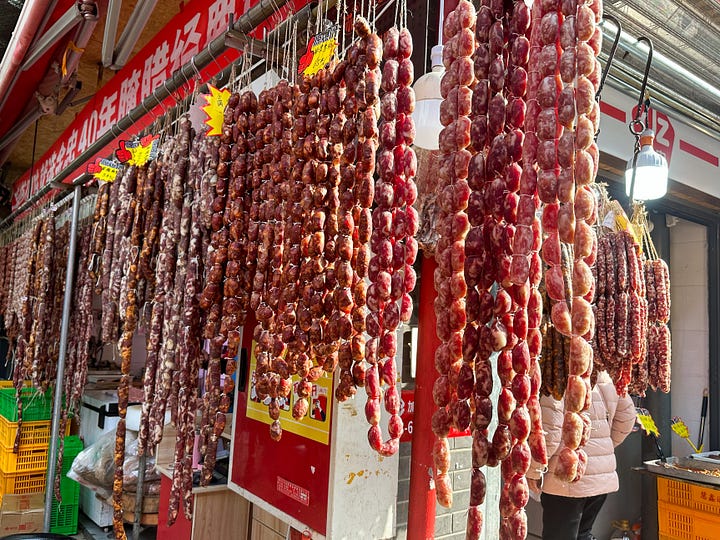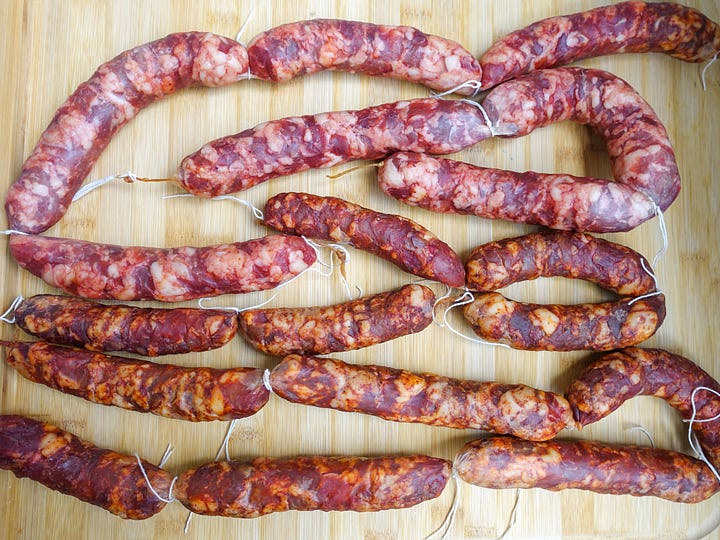Sichuan Wind-Cured Sausage (Xiang Chang)
Making traditional sausage from scratch-ish for the CNY!
Today is the Chinese New Year’s eve. Growing up in my Sichuan family, the Chinese New Year feast was a tradition that remained consistent. At lunchtime, we’d gather at my fraternal grandparents’ home for a banquet of dozens of dishes. Among the staples: small plates of steamed cured meats—sausages, pork belly, chicken, rabbit, and fish—alongside deep-fried battered pork strips (su rou) and steamed sticky rice, (sweet or with pork belly), complemented by a scattering of vegetable sides. As a kid, it was the highlight of the year—especially because it meant wearing new clothes and eagerly collecting red envelopes filled with cash.
The preparation for cured meats begins in the last lunar month, known as la yue (腊月). Every family busily plans their meats, hanging them out to dry on balconies or courtyards. The tradition of curing meat in China stretches back millennia and is rooted in scarcity. During my parents’ childhood in the planned economy era, fresh meat was a luxury. Families received limited rations, so New Year was one of the few times they enjoyed a bounty of meat. Part of it was eaten fresh, but most was preserved to stretch over the coming months.


In the past, cured meats were always homemade. My mom recalls making sausages with her family in the 1970s. Procuring casings was tricky—my grandfather would rely on veteran friends to save them. The pork was hand-cut in a giant plastic basin, and then stuffed into casings using a bamboo tube. It was a family effort, involving her and her brother. For years, she believed winter was the only time people could enjoy unlimited meat.
By the time I was growing up, this process had largely been outsourced. Families would commission trusted butchers at farmers’ markets to prepare sausages with their preferred cuts and seasonings. Once made, the sausages were brought home to air-dry. According to my grandma, unique family recipes are slowly giving way to mass-produced seasonings, though the essence of the tradition persists.
For years, I felt too intimidated to try making sausages myself. But after seeing fellow Sichuan friends in Berlin successfully recreate them—and inspired by creators like Charlene from the baodega and Mei from daywithmei—I decided to give it a shot. Here’s how I make Sichuan-style sausage in my Berlin home, now for the second year running.
Make Sichuan Wind-Cured Sausage at Home
Chinese sausage-making varies regionally. You might think of Cantonese lap cheong (腊肠) or Harbin-style hong chang (红肠). In Sichuan, the classic sausage is chuanwei xiangchang (川味香肠), defined by its mala flavor—a mix of salt, Sichuan pepper, chili flakes, Chinese baijiu liquor, sugar, and spices. In recent decades, other styles have emerged, including sweet and umami-flavored sausages (guangwei xiangchang, 广味香肠) inspired by lap cheong. Other variations feature green Sichuan pepper, pork ribs, or huo tui chang, a more fine ground sausage with starch that has a Spam-like texture. In my family there were a mix of the mala and guangwei so that’s what I made here.
Basic Process
Essentially, Sichuan sausage is made by slicing (not grinding) pork , marinating it in seasonings, stuffing it into casings, and wind-drying it for days, up to a few weeks, depending on the weather. Traditionally, sausages were also smoked using branches from Chinese thuja trees or pinecones. While smoking is now less common (likely for health reasons) in where my family lives, some countryside families and vendors still practice it.
A Rough Recipe
Ingredients
Makes 18–20 sausage links
3 kg (6.6 lbs) pork (70% lean, 30% fat)
1 bag Sichuan sausage marinade (used for 3 kg meat)
4 tbsp Chinese baijiu liquor (50–60% alcohol, such as Erguotou)
~8 meters of natural hog casings
Tools: large bowls, sausage stuffer, kitchen twine, hooks or racks for hanging, toothpicks
Instructions:
Prepare the Casings:
Rinse the salt from the casings under running water, then soak them in room-temperature water with a splash of baijiu for 2 hours. Wash them inside out and check for any damage.Marinate the Meat:
Thinly slice the lean pork to about thumb-size, 0.5 cm / 0.2 inch thick , and the pork fat into smaller pieces (or grind the pork fat into small cubes in a food processor). Combine with the marinade and baijiu, mixing thoroughly with gloved hands. Let marinate for 2 hours.Stuff the Sausages:
Slide a casing onto the sausage stuffer’s funnel, tying a knot at one end. Fill with marinated meat, guiding it with your hands. Once stuffed, tie off the other end. Divide into 12–15 cm (4-6 inch.) links using kitchen twine, then poke small holes with a toothpick to release trapped air.Wind-Dry the Sausages:
Rinse the links in warm (60°C/140ºF) water, dry them completely, and rub lightly with baijiu. Hang in a cold, dry, well-ventilated area (under 15°C) for 10 days to 2 weeks. Check regularly, thhe sausages should feel firm and dry to the touch when ready.
How to Prepare and Store Sausage
To cook wind-cured sausages, start by rinsing them in hot water to remove any dust or surface residue. Then place the sausages in a pot of cold water and bring it to a boil over medium-high heat. Once boiling, reduce the heat to medium and simmer for about 20 minutes. Remove the sausages from the pot and let them cool until they’re easy to handle. Slice them thinly on the diagonal, then enjoy directly or cook with them
In Sichuan, wind-cured sausages and other cured meats are typically boiled or steamed and enjoyed as part of a warm charcuterie platter served with rice and complementary dishes. You can prepare a larger batch in advance; the sausages reheat beautifully when steamed. In my family, we often steam the sausages in a plate in the rice cooker while cooking rice.
If you’re not ready to use the sausages right away, you can store them raw and un-rinsed in airtight bags or vacuum-sealed packaging in your freezer. These can be frozen for several months.
How to Cook with Sausage
Wind-cured sausages must always be boiled or steamed until fully cooked before being incorporated into other dishes. Once cooked, their are versatile and use them as you would Chinese sausage (lap cheong), experimenting with both mala and sweet-flavored varieties in various dishes:
Fried Rice or Noodles: Slice the cooked sausages and stir-fry them with rice or noodles for an easy flavor boost.
Vegetable Stir-Fries: Stir sausages with vegetables, such as this hand-torn cabbage or with cauliflower or garlic scapes.
Topping for rice: Add sliced sausage as a savory topping to silky congee, steamed rice for a comforting meal.
For sweet-style sausages, one of my favorite uses is in clay pot rice. I loosely followed a recipe from Serious Eats and found it to be a wonderful showcase for the sausage’s umami and sweetness.
When it comes to mala sausages, I took a creative approach and used them as a topping for an easy loaf-pan focaccia recipe by Devan. The results were incredible. If you embrace their resemblance to Italian salami or Spanish chorizo, you could easily use mala sausages in pizza, pasta, or even frittatas.
Tips for Making Sichuan Sausages at Home
Pork Cuts and Ratio
Many Chinese tutorials recommend pork cuts like front leg or shoulder with fat (qiantuirou, 前腿肉). For my batch, I used a combination of cuts: leg, skin-less belly, neck, and pure pork fat. Pork fat is readily available at German grocery stores, and I found that processing it in a food processor saved time while helping bind the sausage mixture for a smoother texture.
The traditional lean-to-fat ratio for Sichuan sausages is about 70:30 or 80:20, less fat for a firmer, chewier texture.
Drying Conditions
The ideal environment for curing sausages is cold, dry, and well-ventilated place in winter, which is why most Sichuan families hang them on balconies in winter. Sun exposure is also common in some areas. In Berlin, I’ve made sausages in January for the past two years when the temperatures stay below 10°C (50°F). Before starting, I check the weather forecast for the next two weeks to avoid rain or unseasonable warmth. If unexpected rain occurs, you can temporarily store the sausages in the refrigerator and resume drying afterward. I’ve placed an umbrella over my outdoor drying rack to prevent dripping from the snowy days and the sight of greedy crows.
In Sichuan, I’ve seen people making sausages in spring using electric fans to speed up the drying process. According to the Encyclopedia of Sichuan Cuisine, industrially produced sausages are dried in a dehydrator or oven at 60°C/140°F for 48 hours, so an oven could be an alternative for home cooks. Properly dried sausages should feel firm and dehydrated, smell fragrant, and show no signs of mold. Avoid warm, humid conditions to ensure food safety.
Products and Tools I Used
Sausage Seasoning
I rely on ready-made sausage seasoning, which I’ve found to be both reliable and consistent, especially given my limited experience with curing meat. I bought mine from China, but similar options are available online in the U.S. Brands like Haorenjia (好人家, the one i used for this batch), Shuxiang (蜀香), and Jin Gong (金宫) are commonly used in Sichuan and come recommended by my grandma. Here are a few links (shop on your own risk pls): Jin Gong five-spice sausage seasoning, Haorenjia Cantonese-flavoring sausage seasoning, Shuang Hui Mala Sausage seasoning.
Alternatively, you can make your seasoning from scratch, the salt and liquor part is most important for the safety reasons. For reference, Chef Wang Gang’s recipe includes: 2.5 kg pork, 80g chili, 65g kosher salt, 25g baijiu liquor, 20g sugar, 10g five-spice powder, and a few tablespoons of green Sichuan peppers. He recommends that the weight ratio of meat to salt should be 40:1.
The book The Processing Techniques of Traditional Chinese Cured and Preserved Meats (《中国传统特色腌腊肉制品加工技术》) suggests a rough percentage of ingredient: 3–5% salt, 1–2% sugar, and 1–3% baijiu by weight of the meat, with optional soy sauce and spices.
Sausage Casings
I used salt-preserved natural hog casings (28–30mm diameter). These are similar in size to those used for German bratwurst or frankfurters, about 2–3 cm wide. These can be sourced from a local butcher or online supplier. Thoroughly rinse and soak the casings in water for several hours before use.


Sausage Stuffer
I use a manual sausage stuffer (similar to this), which requires an extra set of hands to help but is affordable, easy to clean, and gets the job done. However, it’s relatively slow, as you have to re-feed the meat after stuffing about one link of sausage. Electric stuffers or sausage attachments for stand mixers like KitchenAid are faster and more efficient options.










My grandma used to cure sausages every winter 😌🧊 would love to try it one day. Thanks for sharing!
Lassen Sie diese nicht nach draußen, um in Deutschland zu heilen, Sie könnten einige verlieren! 😉